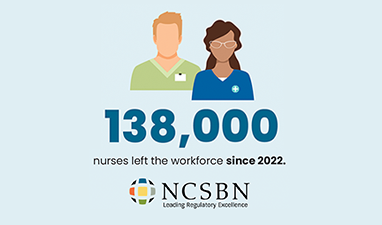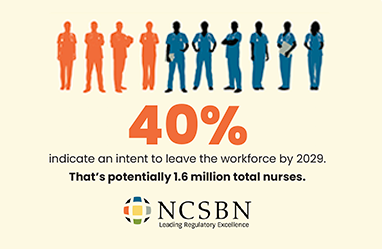Leaders in U.S. Nursing Workforce Research

NCSBN — the world leader in nursing regulatory knowledge and advancement — released its 2024 National Nursing Workforce Study, surveying 800,000 nurses to understand the state of the workforce. The study is considered to be the largest and most comprehensive research study of the nursing workforce, uncovering the data points which have far reaching implications for the health care system at large and for patient populations.
See Full Results in Journal of Nursing Regulation

Small Steps Toward Nursing Workforce Recovery; Burnout and Staffing Challenges Persist
The 2024 data reveal that more than 138,000 nurses left the workforce since 2022 and by 2029, almost 40% of nurses intend to leave the workforce, reinforcing concerns about ongoing labor shortages and systemic workforce challenges.
Read the Press Release
2022 Survey Impacts
Nurses’ participation in the 2022 National Nursing Workforce Survey raised a new level of awareness of issues critical to the field of nursing. The concerns raised from the survey reached over 200 million people via prominent media outlets and led to discussions among nursing leaders on how to address the workforce crisis.
Nursing at the Crossroads: A Call to Action
This presentation details how the pandemic impacted nurses, how many left the workforce in this period and forecasts how many more plan to leave nursing.
Solutions Addressing Nursing Workforce Crisis
This symposium brought together leading health care professionals to discuss ways they are proactively addressing nursing wellness, staffing and workplace safety.
Didn't find what you are looking for? Contact us with any comments or questions.
Submit an Inquiry






